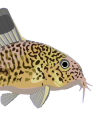| Scientific Name | Pterodoras granulosus (Valenciennes, 1821) |
| Common Names | Granulated Catfish Armado (Venezuelan), Bacu (Brazilian), Common Bacu, Ru Tornmalle (Denmark) |
| Type Locality | South America. |
| Synonym(s) | Doras granulosus, Doras laevigatulus, Doras lentiginosus, Doras maculatus, Doras murica, Megalodoras laevigatulus, Parapterodoras paranensis, Pterodoras lentiginosus, Silurus 12-radiatus, Silurus armatus, Silurus duodecimradiatus |
| Pronunciation | gran you LOW sus |
| Etymology | Pterodoras: From the Greek pteron, meaning fin, and doras, meaning skin (also a word commonly used in forming generic names for doradids); in reference to the forked caudal fin. |
| Articles | |
| Size | 700mm or 27.6" SL. Find near, nearer or same sized spp. |
| Identification | The colour pattern of these catfish varies depending upon the location that they originate from. These fish are usually a muddy-brown colour with some darker spots over the body and fins. As these fish mature the spotting tends to fade. Juvenile specimens tend not to be as dark coloured as adult fish, |
| Sexing | There are no reported external sexual differences. Personal observation shows that females tend to be more heavily built/robust than the males, which tend to be slender. There may also be differences associated with the structure of the head as with the Synodontis catfish, but further observations need to be made. |
| Distribution | South America: Amazon and Paraná River basins and coastal drainages in Guyana and Suriname. Amazon (click on these areas to find other species found there) La Plata, Paraná (click on these areas to find other species found there) La Plata, Uruguay, Lower Uruguay (click on these areas to find other species found there) Login to view the map. |
| IUCN Red List Category | Least Concern , range map and more is available on the IUCN species page. Last assessed 2020. |
| pH | 6.4 - 7.6 |
| Temperature | 20.0-24.0°C or 68-75.2°F (Show species within this range) |
| Other Parameters | Wamer water will be tolerated at least for a period of time. It is documented that keeping these fish in water with a pH value above 7.5 can cause skin and eye cloudiness. |
| Feeding | Omnivore feeding on a very mixed and varied diet including catfish pellets, earthworms, whole prawns, mussels, floating sticks/pellets and snails. In their natural environment they would feed upon snails, aquatic plants and fruits. See also natural feeding behaviour paper in the references section. User data. |
| Furniture | Large pieces of bogwood are ideal. Large diameter pipe can be used but it should be large enough for the catfish to easily fit in without becoming stuck. I have managed to create two shady areas within my tropical pond, by covering the ends with decking, where these catfish prefer to hide until feeding time. |
| Compatibility | Ideally suited to life with other large fish. These catfish are not predatory but would mistakenly take a smaller fish if hungry. |
| Suggested Tankmates | Other large catfish such as Leiarius, Megalodoras, Oscars and larger characins. |
| Breeding | There are no known aquarium spawnings of this catfish. This is most likely due to the size that these fish can attain and hence the subsequent size of aquarium in which to spawn them. |
| Breeding Reports | There is no breeding report. |
| Reference | Voyage de Humboldt et Bonpland v. 2 (Title page 1833), pp 184. |
| Registered Keepers | There are 28 registered keepers, view all "my cats" data. |
| Wishlists | Love this species? Click the heart to add it to your wish list. There are 3 wishes to keep this species, see who wants what. |
| Spotters | Spotted this species somewhere? Click the binoculars! There are 14 records of this fish being seen, view them all. |
| Forum BBCode | |
| Search for P. granulosus | |
| Look up P. granulosus on AquaticRepublic.com | |
 | Look up P. granulosus on Fishbase |
 | Look up P. granulosus on Encyclopedia of Life |
 | Look up P. granulosus on Global Biodiversity Information Facility |
| LFS label creator ARN ref:1.12.156.524 | |
| Last Update | 2025 Jan 02 01:36 (species record created: 2001 May 04 00:00) |





/siluriformes/doradidae/pterodoras/granulosus/1.jpg)
/siluriformes/doradidae/pterodoras/granulosus/2.jpg)
/siluriformes/doradidae/pterodoras/granulosus/3.jpg)
/siluriformes/doradidae/pterodoras/granulosus/4.jpg)
/siluriformes/doradidae/pterodoras/granulosus/5.jpg)
/siluriformes/doradidae/pterodoras/granulosus/6.jpg)
/siluriformes/doradidae/pterodoras/granulosus/7.jpg)
/siluriformes/doradidae/pterodoras/granulosus/8.jpg)
/siluriformes/doradidae/pterodoras/granulosus/9.jpg)
/siluriformes/doradidae/pterodoras/granulosus/10.jpg)
/siluriformes/doradidae/pterodoras/granulosus/11.jpg)
/siluriformes/doradidae/pterodoras/granulosus/12.jpg)
/siluriformes/doradidae/pterodoras/granulosus/13.jpg)
/siluriformes/doradidae/pterodoras/granulosus/14.jpg)
/siluriformes/doradidae/pterodoras/granulosus/15.jpg)
/siluriformes/doradidae/pterodoras/granulosus/16.jpg)
/siluriformes/doradidae/pterodoras/granulosus/17.jpg)
/siluriformes/doradidae/pterodoras/granulosus/18.jpg)
/siluriformes/doradidae/pterodoras/granulosus/19.jpg)
/siluriformes/doradidae/pterodoras/granulosus/20.jpg)
/siluriformes/doradidae/pterodoras/granulosus/21.jpg)